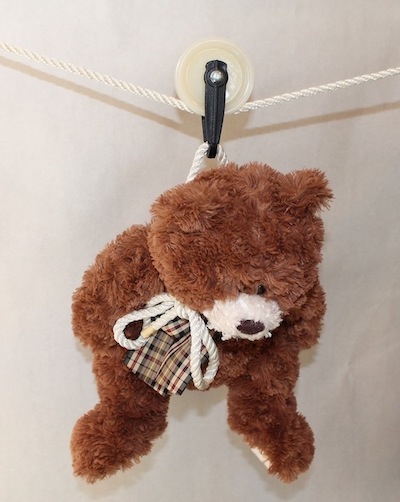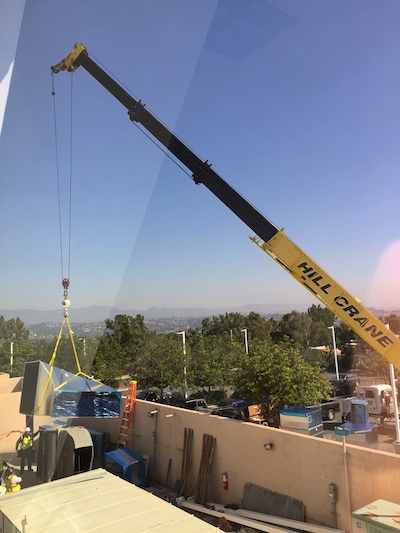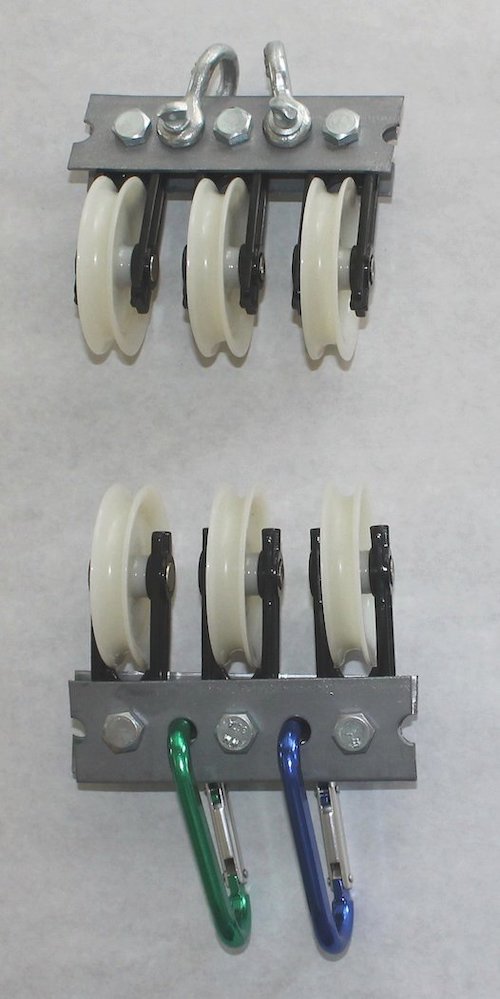Ropes and Pulleys
A few toy machines that you can make with ropes and pulleys from the hardware store.
If your Home Depot is like the ones around here, you can buy a handful of pulleys and a hundred feet of rope for about $30. The pulleys come in a variety of kinds, but the kind I like best for mechanics toys are the large plastic “clothesline pulleys,” like this:

With a batch of pulleys and a bunch of rope, you can play around with various kinds of rigging, and discover a few rules of “simple machines.”
A Zip Line
One of the simplest toys you can make with pulleys is to make a “zip line.” If you have a long rope or cable with one end higher than the other, and drawn taut so that it doesn't sag too much in the middle, then you can hang something on a pulley on the rope and it will roll down the rope from the high end to the low end. Sometimes people ride down such a line on vacation for fun. NASA used such a system to allow astronauts to quickly get far away from the launch vehicle on the launch pad, in case something ever went wrong with the rockets. You can make a toy zip line at home in a couple of minutes.
You just tie a pulley to a teddy bear or something, then get a really long rope and tie it to something at both ends, with one end high and one end low. You may prefer just to have your kids hold the ends, to make it easier to take the “rider” off of the low end and return it to the upper end. I made one for the kids at my school to use at recess, descending into the recess yard from an upper floor balcony, and it seemed pretty popular (although the novelty wore off pretty quickly).

The Power of Pulleys
The real magic of pulleys comes when you use them to lift and pull on heavy weights. To discuss this subject, I'm going to provide a series of videos I made many years ago for an online science course. They are informal and not high-quality, but I think I gave a pretty good introduction to the power of pulleys. I recommend watching them in order.
Someday I'd like to re-make my videos into something more formal, with higher video quality and better instructions for how to make models that students can play with in class … but Smarter Every Day has already made a pretty good video showing more or less what I wanted to show, and then some.
If you pay attention the next time you are wandering around a marina, you may be able to find several examples of rope-and-pulley systems. Keep your eyes open and check out the cranes the next time you pass a construction site, as well.

Block-And-Tackle
You can usually arrange toy single-pulley systems and toy Spanish Burton systems simply with pulleys and rope. Manufacturing “blocks” for a block-and-tackle system requires a little more work. I made mine by fastening together two sets of three pulleys. I used strips of “punched sheet metal,” cut to length with my bolt-cutters, and I bolted the three pulleys through the holes. You could also use strips of wood with holes drilled into them. You need two “blocks,” or two sets of pulleys: an upper block to fasten to the building or to a framework of some kind, and a lower block to attach to the weight you wish to lift. You also need a way to conveniently fasten the two blocks to their respective mounts. I used a pair of “anchor shackles” in one of my blocks, and a pair of “spring links” in the other, and they both worked reasonably well. Then I just used short sections of rope through the loops to tie the blocks to their mounts. I found all of the equipment for this in the same store as the pulleys, a few paces away.

After assembling and mounting your two blocks — the upper block to a tree branch or swing set or something, and the lower block to something heavy, like a $1 concrete block from the same hardware store — then you need to rig the rope. Assuming you have two blocks of three pulleys each, start by tying one end of the rope to the frame or tree branch or to one of the anchor shackles of the upper block. Then you run the rope down and under the first lower pulley, up and over the first upper pulley, down and under the second lower pulley, and so forth, until the rope comes out and over the last upper pulley. Plan on spending a long time rigging the pulleys — it can be quite an annoying chore.
When you are all done, and the rope runs freely through all of the pulleys, you should be able to pull down on the free end of the rope, and slowly but easily lift the heavy weight. It might be fun to tie another rope to a similar weight, and merely run it over a single pulley mounted to the same tree. Do you notice the difference when you pull down on the two ropes? Do you notice anything else when you try to lift the two weights? The block-and-tackle comes with a big benefit: it allows you to lift a large weight with a small force. If you were to measure the weight and the force, can you guess what the ratio might be? Does the block-and-tackle also come with a penalty? Is there a price that you have to pay to get the larger force?